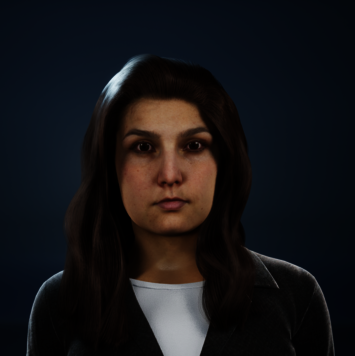Virtual Humans in the Brabant Economy - VIBE - is not just any collaboration. It was the very first MindLabs project ever. Back in January 2018, 13 organizations joined forces. The ecosystem then received 7 million euros in European funding to finance VIBE. Prof. Dr. Max Louwerse is Professor of Cognitive Psychology and Artificial Intelligence at Tilburg University and initiator of the project: "What makes VIBE special is the collaboration between the different partners. Not only knowledge institutions (Breda University of Applied Sciences, Fontys and ROC Tilburg) and hospitals (Maxima Medisch Centrum and Spaarne Gasthuis) are involved. The industry also plays a major role. VIBE thus fits exactly with the idea behind MindLabs."
Almost real because of AI
The VIBE avatars communicate with people through speech, facial expressions and movement, without knowing what the human user will say. This is where artificial intelligence comes in. AI helps with this form of communication. The avatars are fed algorithms based on specialist knowledge. For the credibility of the Virtual Humans, it is important that they appear as human-like as possible, including the right eye gaze and facial expressions. At Tilburg University, aspects such as language and non-verbal communication are therefore thoroughly investigated. Among others by PhD students Guido Linders and Julija Vaitonyte.
Tilburg research
Linders' research looks at how people use language and how these data can then be converted into mathematical and computational models. Because only with such models can avatars "understand" language. Vaitonyte, in turn, looks at which non-verbal aspects, aspects in its appearance and visual behaviors make avatars human. She is also investigating how these can then be measured with physiological (brain activity) or behavioral measurements. Measuring whether agents are human-like is important to further improve the appearance and behaviors of the avatars.
Another essential pillar in the research of the team from Tilburg University, is linking the verbal (language) and non-verbal aspects (facial expressions). This involves first measuring in real humans when they apply nonverbal communication. Think of looking at an interlocutor or nodding occasionally during a conversation. Next this is implemented in the avatars. All these aspects ensure that the Virtual Humans become as human-like as possible.
Bariatric patient support and training on pregnancy complications
The communicating avatars that are now being developed will soon be seen in at least two places. The bariatrics department (obesity treatment) in the Spaarne Gasthuis is one of them. The idea is that in the future an avatar will be able to provide part of the patient information on obesity care. The major advantage of this construction is that, unlike the average doctor, a virtual person is always available.
In the Maxima Medisch Centrum in Eindhoven, the second location, the avatar will soon be used as a training tool for nursing staff. The conversational avatar is currently being programmed so that it can tell trainees everything about heavy blood loss during childbirth. The staff of this hospital will in due course receive practical training from the virtual trainer.
Multidisciplinary collaboration
In the future, the avatars from this MindLabs project will primarily have a supporting role. They will not replace the staff, but they will be a welcome addition. Not only in healthcare, but also in education, for example. Louwerse: "Because VIBE is now focusing mainly on deployment in hospitals, but there are many more opportunities. For example, in business, aviation and schools."
The grant for the VIBE project runs until the end of this year.
Want to know more about the project? Then click here.
The VIBE project is a collaborative innovation project enabled by the European Union, OP Zuid, the Dutch government, the province of Noord-Brabant, and the municipality of Tilburg to enforce the regional innovation system.

